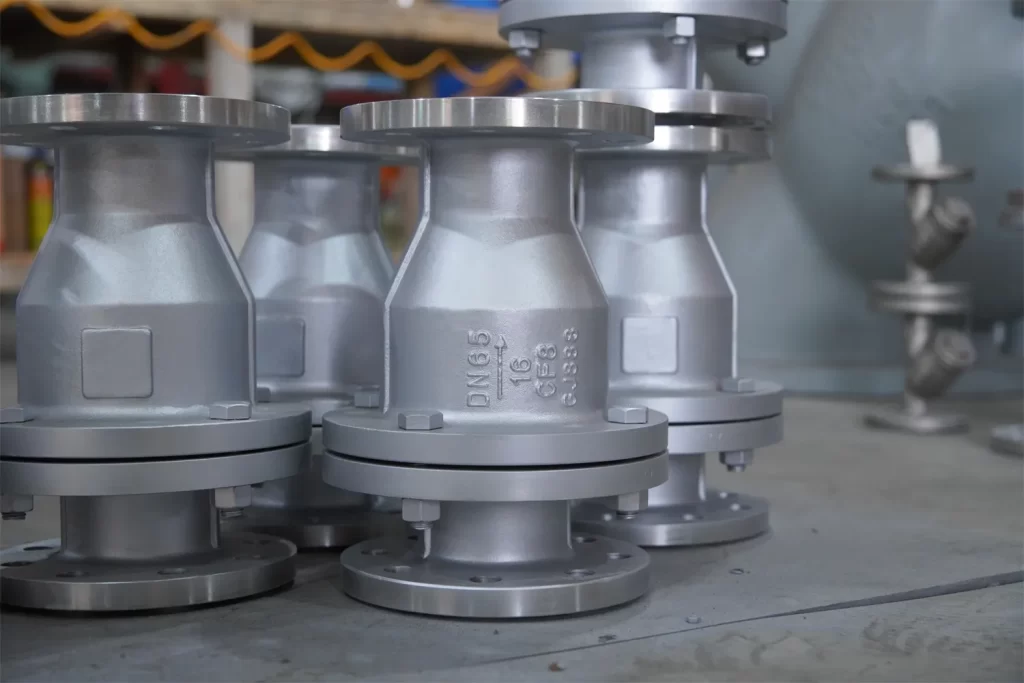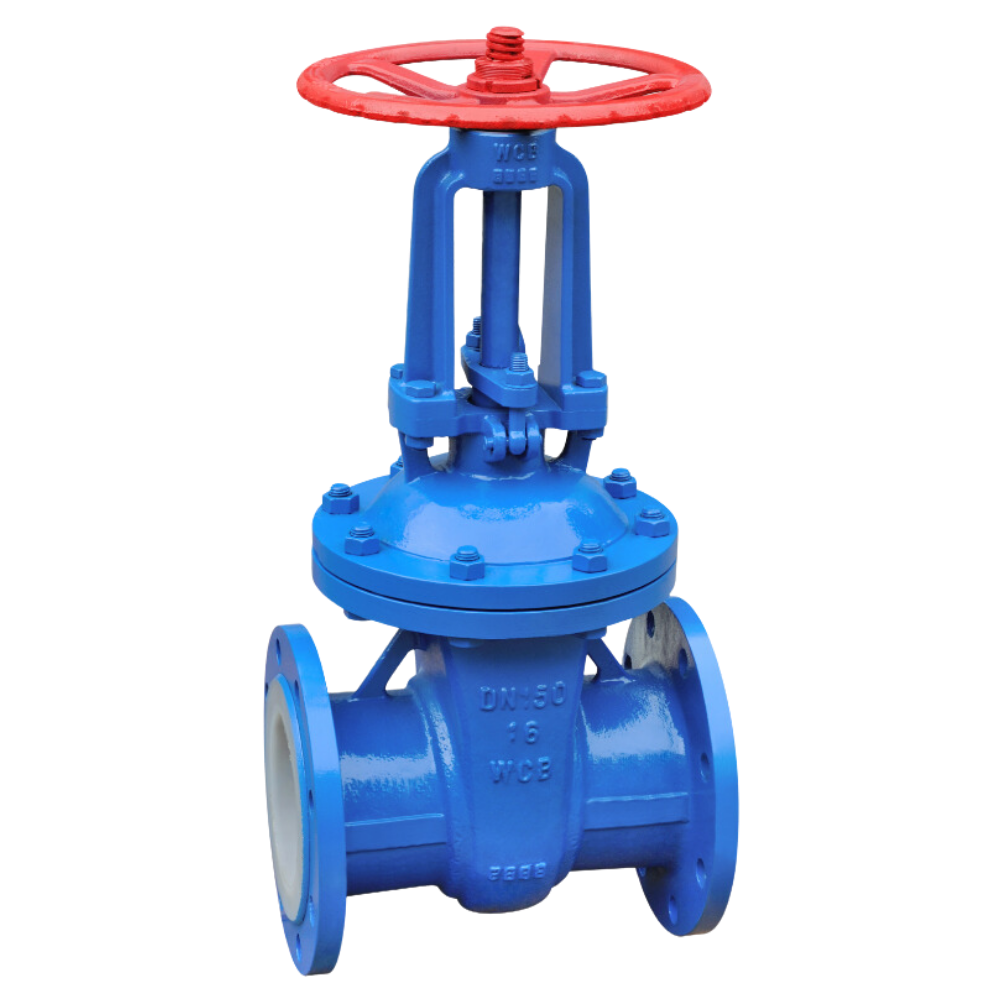

Stainless steel ball valves are known for their durability and high temperature resistance. These valves use a rotating hollow ball to control fluid flow. The alloy layer of stainless steel/nickel and chromium allow these valves to be used in chemical and oil/gas plants.
These valves have many different types with each valve either differentiating in use or connection types.

Just like the name, stainless steel ball valves utilize a rotating hollow ball to allow/block fluid flow. These valves are opened/closed by moving the external handle around a 90 degree axis. When the valve’s external handle is parallel to the fluid flow and valve itself, the ball rotates, opening the valve and allowing fluids to pass through.
Shifting the external handle perpendicular to the valve and fluid flow closes the valve. The 90 degree opening/closing axis is why they are also termed as quarter turn valves. The rotating ball that we mentioned is generally hollow with a hole bored in it. Once the external handle moves, the ball rotates and the hole falls in line with the fluids, allowing them to flow through. This is then reversed once the handle is moved back.
A full port ball valve is made to match the diameter of pipes. These allow for unrestricted optimal fluid flow. For pipes with a certain diameter, the best full port ball valve to go for is one with the same diameter.
A reduced port ball valve is also termed as a standard port ball valve. Unlike the full port ball valve, these come with a smaller diameter. Hence, they tend to restrict fluid flow. These valves are used for industrial operations as they are cheaper. Mostly, a 6 inch diameter pipe can be fitted with an 8 inch reduced port ball valve to get the same effect as that of a full port ball valve.
Just like the name, a 2-piece ball valve comes with two main sections. The larger section allows the utilization of a larger ball. In turn, this means that full port flow/unrestricted flow is possible with these valves.
A 3-piece ball valve comes with a separate middle section which holds the main internal components such as the ball and seat. Two opposite sides of the middle section are kept to connect valves to pipes. The addition of a third section allows for simpler installation and lower maintenance. These valves are more expensive but durable, hence having more long term advantages.
To put it simply, a flanged ball valve is a type of ball valve that connects to pipes through flanged ends. These valves feature a lifted front or ring-esque flange that is joined to pipes.
A threaded ball valve includes female NPT threads which can be connected to pipes that have male NPT threads. The remaining structure is identical to that of a normal ball valve.
A trunnion mounted ball valve is better suited for higher pressure operations. These valves include a solid ball that is helped by a trunnion from above and below. The trunnion provides support by lowering the effects of torque. This extra support is what makes these valves ideal for higher pressure use.
A floating ball valve is better suited to low pressure situations. In this case, the opening/closing of the valve is controlled by a ball floating on top of the fluid. When the valve is opened, the ball starts to float and fluid flows through. The opposite happens when the valve is closed.
Ball valves also come in different specialized forms such as the cryogenic ball valve, high pressure ball valve, sanitary ball valve, multi-port ball valve, and v-port ball valve. These ball valves differ by the shape of the hole that’s drilled in the ball. The V-port ball valve has a V shaped hole. This hole comes in differentiable sizes determined by the angle. The most common bore openings are 15, 30, 45 or 60 degrees.
The advantages and limitations of each kind of ball valve are as follows:
Ball valves are most often found in these industries:
Ball valves should only be bought if they are compliant with industry standards. Make sure that each product comes with ASME, API, ISO or CE certifications.
Different kinds of ball valves are suited to different pressure/temperature ratings. These can be confirmed by cross checking data with pressure/temperature standards or certifications.
Ball valves come in different connection types such as flanged or threaded valves. Choose the one which fits your setup.
All kinds of ball valves require the same regular maintenance routines in order to prolong their use. A general maintenance routine can be seen below:
Founded in 1982, Lianke Valve is one of China’s best valve suppliers. Here, customers will find an endless variety of valve products all of which are compliant with top notch industry standards. Our valve designs combine efficiency with high performance making sure that your fluid flow control needs are always met.
Each ball valve comes with a detailed description telling you about all the different types that are available. Looking to get a quote? Request one and get a reply in just 24 hours!
Ball valves work by the movement of a rotating ball with a bore. This ball is connected to an external handle. When the handle is parallel to fluid flow, the valve is opened. When it’s moved back to its original position, the bore no longer faces the fluid, blocking flow.
To select the right stainless steel ball valve, ensure that it is compliant with API, ISO or CE industry standards. Additionally, check whether the API pressure standards and type of ball valve are suitable for your system.
Resources:
V-Port Ball Valves and Their Uses | Tameson.com
Full Port Ball Valve vs. Standard Port: Which One to Choose? (dombor.com)
Flanged vs. Threaded Ball Valves: Choosing the Right End Connection (xintaivalves.com)

Gate valves control fluid flow in various industrial applications. They can completely stop or allow flow, depending on the valve’s position. Valves, in general, share the same function — but what makes gate valves different? This article will explore what gate valves are, how they work, their components, types, and common issues, among other important […]

In Brazil’s booming sugar industry, industrial strainers play a crucial role in ensuring clean, uninterrupted production during juice clarification, sugar syrup filtration, and the crystallization process. With sugar mills handling high-viscosity, abrasive fluids like massecuite and syrup, selecting a reliable strainer manufacturer is essential for maintaining syrup purity, minimizing downtime, and meeting hygiene standards. This […]

South Africa’s gold mining sector relies heavily on robust flow control systems that can withstand abrasive slurry and harsh tailings. Heavy-duty pinch valves play a crucial role here, offering durability, low maintenance, and resistance to extreme pressure. In this guide, we rank the Top 5 Heavy-Duty Pinch Valve Manufacturers South African mines trust for reliability. […]

Desalination facilities in Saudi Arabia face one of the most extreme operating environments—high salinity, abrasive media, and fluctuating brine discharge pressures. In this high-demand sector, pinch valves play a vital role in managing flow control for seawater reverse osmosis (SWRO) and thermal desalination processes. This guide ranks the top 5 pinch valve manufacturers for Saudi […]



